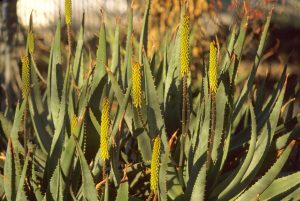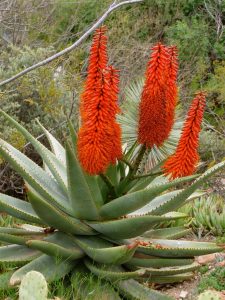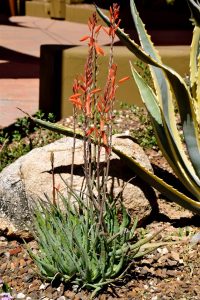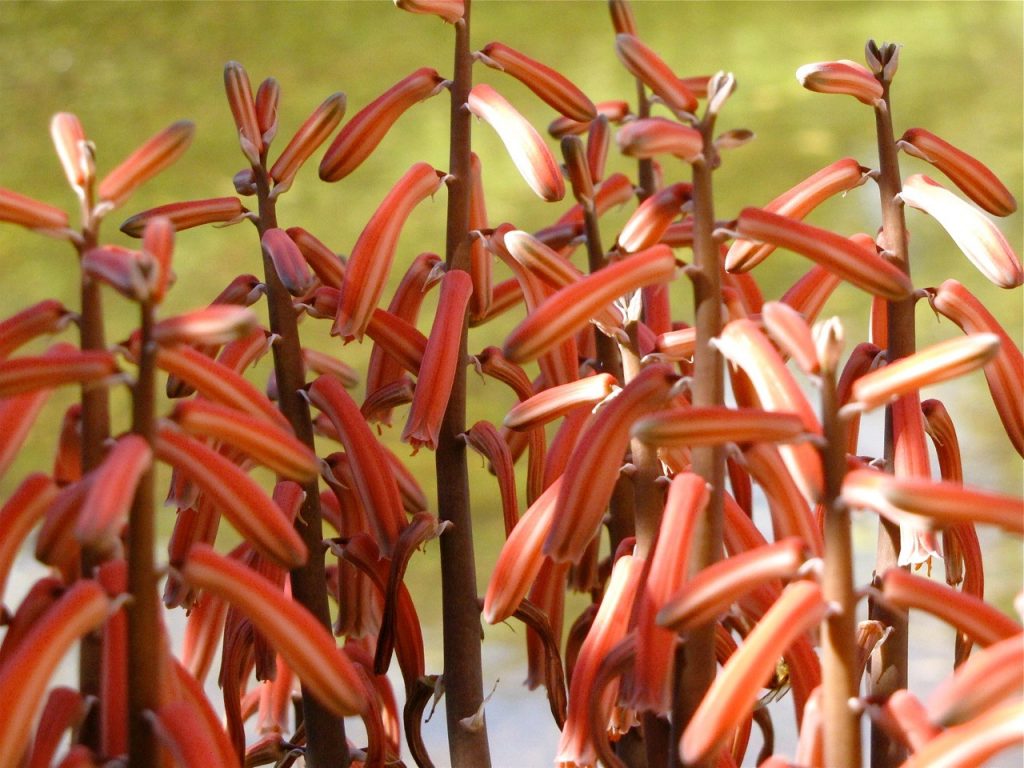Aloes are striking succulents from southern and eastern Africa that offer some of the best color for Arizona gardens with their impressive and long-lasting show of flowers during the winter and early spring. Aloes have numerous forms ranging from low groundcovers to treelike species. Small clustering forms work well in containers and the tree forms work well as accents or planted in mass, particularly with groundcovers and wildflowers. Their tubular flowers borne on long flowering stalks range in color from yellow to coral to intense red-orange and attract hummingbirds to the garden. The sharp-tipped leaves have pale to reddish-brown teeth along the margins. The rosettes do not die after flowering, and many species of aloe produce offsets that spread to cover large areas.
Aloes have a wide range of hardiness, but most species suffer some damage to their rosettes and flower stalks much below 24 degrees Fahrenheit. They are more attractive in containers which can be moved to provide protection from frost or sunburn. They can take full winter sun and are heat and drought tolerant, but look better in the summer with partial or filtered shade and occasional watering. They are tolerant of most soils, but require good drainage. They are very easy to grow and require little maintenance other than removing dead flower stalks and dividing crowded clusters. Although largely pest-free in our area, they can be affected by the aloe mite which causes cancerous growth on the flower stalk and leaves. Prompt removal of the affected plant parts will prevent the spread of this problem.

Aloe barbadensis (also known as Aloe vera), Medicinal Aloe
This 2 foot high aloe with light green leaves forms clusters up to 6 feet in diameter with brilliant yellow flowers in the spring. The sap of medicinal aloe has been used since ancient times to treat burns and skin problems. Used as a groundcover under desert trees, this plant provides early spring color and unique texture in the arid garden. It can also be used as an indoor or outdoor potted specimen.

Aloe ferox, Tree Aloe
Tree aloe can eventually form a solitary trunk 6 to 10 feet tall with heavily toothed, 2 foot long, blue-green leaves. Branching, upright flower stalks bear impressive orange-red blooms during the winter and early spring. Aloe ferox can be used as a striking accent, especially in a courtyard container, and works well when planted with Euphorbia rigida or flowering groundcovers.

Aloe x ‘Blue Elf’, Blue Elf Aloe
Blue Elf aloe is a low-growing, compact aloe hybrid that is easy to grow whether located in the planters or in the ground. It’s often touted as one of the easiest aloes to grow. Blue Elf tolerates reflected heat and colder temperatures better than most aloe’s and can even be planted in full sun. Tall spikes of orange flowers are frequented by hummingbirds in late winter to early spring.
This feature is based on a concept and text originally developed jointly by the Arizona Nursery Association and the Arizona Municipal Water Users Association (AMWUA) with partial funding from the Arizona Department of Water Resources. Learn more about these and other great desert plants at the Arizona Municipal Water Users Association Landscape Plants for the Arizona Desert plant database, or see our previously featured Plant of the Month blogs.


